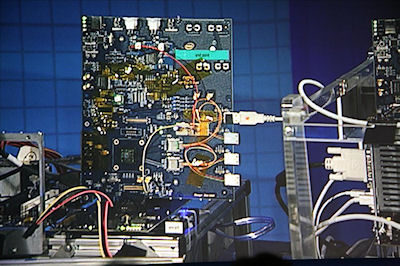I/O silver!
The execs discussed how the high-speed optical I/O technology might improve bandwidth and flexibility while also greatly reducing the cost as well as the complexity of masses of tangled cables for PC users wanting to quickly download videos or other digital media.
Postley noted that 50 copper-based cables on the set of a 3-D shoot could, in fact, be replaced with a single optical cable with Light Peak technology instead. This also opens up avenues for the technology to eventually be integrated in the work station and eventually the consumer market.
To add to its lightening fast data transfer speeds, Light Peak technology also has the currently unique ability to simultaneously transport multiple existing I/O protocols, bi-directionally.
Sadly, Light Peak is still only in its developmental stages, but Rattner said Intel would be working with the industry to find the best way to make the technology into a standard and to push for its adoption across a plethora of devices including PCs, handhelds, consumer electronics and more.















